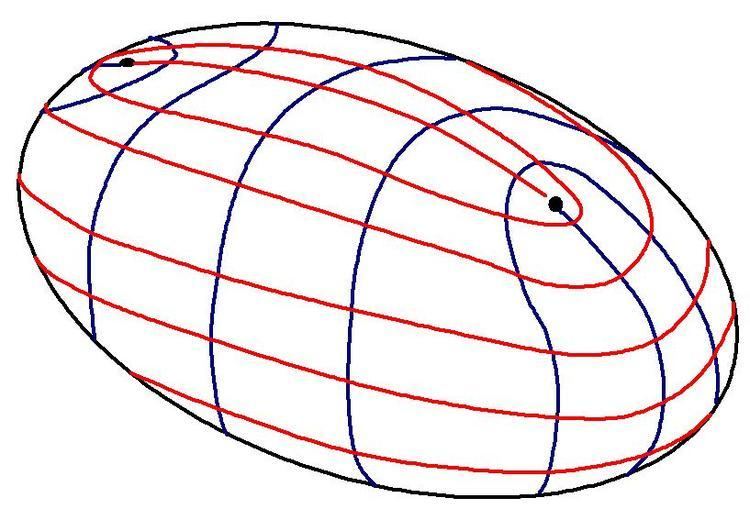 | ||
In the differential geometry of surfaces in three dimensions, umbilics or umbilical points are points on a surface that are locally spherical. At such points the normal curvatures in all directions are equal, hence, both principal curvatures are equal, and every tangent vector is a principal direction. The name "umbilic" comes from the Latin umbilicus - navel.
Contents
- Cubic forms
- Umbilic classification
- Focal surface
- Definition in higher dimension in Riemannian manifolds
- References
Umbilic points generally occur as isolated points in the elliptical region of the surface; that is, where the Gaussian curvature is positive. For surfaces with genus 0, e.g. an ellipsoid, there must be at least four umbilics, a consequence of the Poincaré–Hopf theorem. An ellipsoid of revolution has only two umbilics.
The sphere is the only surface with non-zero curvature where every point is umbilic. A flat umbilic is an umbilic with zero Gaussian curvature. The monkey saddle is an example of a surface with a flat umbilic and on the plane every point is a flat umbilic. A torus can have no umbilics, but every closed surface of nonzero Euler characteristic, embedded smoothly into Euclidean space, has at least one umbilic. An unproven conjecture of Constantin Carathéodory states that every smooth topological sphere in Euclidean space has at least two umbilics.
The three main type of umbilic points are elliptical umbilics, parabolic umbilics and hyperbolic umbilics. Elliptical umbilics have the three ridge lines passing through the umbilic and hyperbolic umbilics have just one. Parabolic umbilics are a transitional case with two ridges one of which is singular. Other configurations are possible for transitional cases. These cases correspond to the D4−, D5 and D4+ elementary catastrophes of René Thom's catastrophe theory.
Umbilics can also be characterised by the pattern of the principal direction vector field around the umbilic which typically form one of three configurations: star, lemon, and lemonstar (or monstar). The index of the vector field is either −½ (star) or ½ (lemon, monstar). Elliptical and parabolic umbilics always have the star pattern, whilst hyperbolic umbilics can be star, lemon, or monstar. This classification was first due to Darboux and the names come from Hannay.
Cubic forms
The classification of umbilics is closely linked to the classification of real cubic forms
The equivalence classes of such cubics under uniform scaling form a three-dimensional real projective space and the subset of parabolic forms define a surface – called the umbilic bracelet by Christopher Zeeman. Taking equivalence classes under rotation of the coordinate system removes one further parameter and a cubic forms can be represent by the complex cubic form
A second cubic form, the Jacobian is formed by taking the Jacobian determinant of the vector valued function
Umbilic classification
Any surface with an isolated umbilic point at the origin can be expressed as a Monge form parameterisation
The classification of umbilic points is as follows:
In a generic family of surfaces umbilics can be created, or destroyed, in pairs: the birth of umbilics transition. Both umbilics will be hyperbolic, one with a star pattern and one with a monstar pattern. The outer circle in the diagram, a right angle cubic form, gives these transitional cases. Symbolic umbilics are a special case of this.
Focal surface
The elliptical umbilics and hyperbolic umbilics have distinctly different focal surfaces. A ridge on the surface corresponds to a cuspidal edges so each sheet of the elliptical focal surface will have three cuspidal edges which come together at the umbilic focus and then switch to the other sheet. For a hyperbolic umbilic there is a single cuspidal edge which switch from one sheet to the other.
Definition in higher dimension in Riemannian manifolds
A point p in a Riemannian submanifold is umbilical if, at p, the (vector-valued) Second fundamental form is some normal vector tensor the induced metric (First fundamental form). Equivalently, for all vectors U, V at p, II(U, V) = gp(U, V)
A submanifold is said to be umbilic (or all-umbilic) if this condition holds at every point "p". This is equivalent to saying that the submanifold can be made totally geodesic by an appropriate conformal change of the metric of the surrounding ("ambient") manifold. For example, a surface in Euclidean space is umbilic if and only if it is a piece of a sphere.
